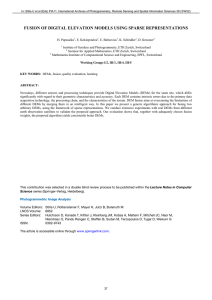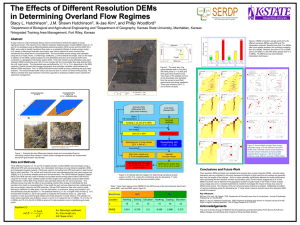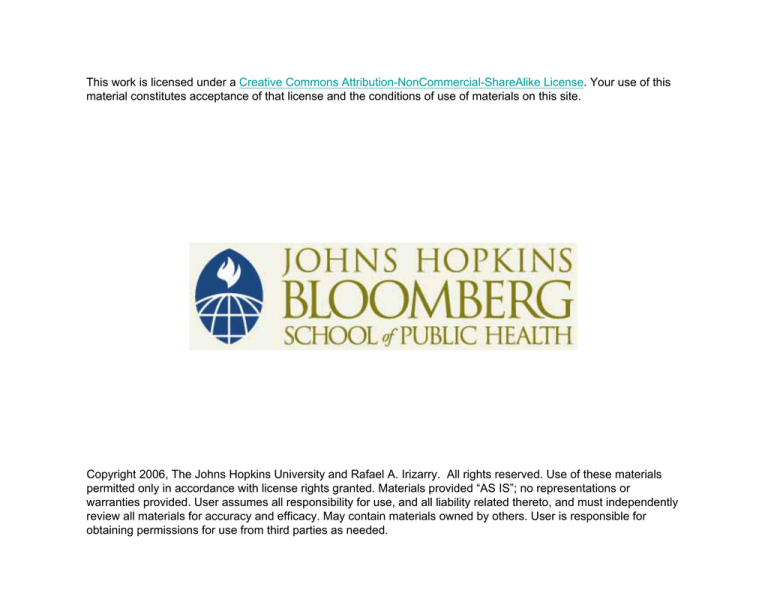
This work is licensed under a Creative Commons Attribution-NonCommercial-ShareAlike License. Your use of this
material constitutes acceptance of that license and the conditions of use of materials on this site.
Copyright 2006, The Johns Hopkins University and Rafael A. Irizarry. All rights reserved. Use of these materials
permitted only in accordance with license rights granted. Materials provided “AS IS”; no representations or
warranties provided. User assumes all responsibility for use, and all liability related thereto, and must independently
review all materials for accuracy and efficacy. May contain materials owned by others. User is responsible for
obtaining permissions for use from third parties as needed.
Statistical Learning: Algorithmic and
Nonparametric Approaches
Rafael A. Irizarry
Department of Biostatistics
Johns Hopkins University
Fourth Term 2005-2006
Chapter 1
Review
The purpose of this class is for you to learn some modern statistical and algorithmic techniques commonly used in scientific research. By the end of the term
you should be able to read papers that used the methods critically or analyze data
using them.
When using any of these tools we will be asking ourselves if our findings are
“statistically significant”. For example, if we make use a particular classification
algorithm and find that we can predict the outcome of 7 out of our 10 cases,
how can we determine if this could have happened by chance alone? To be able
to answer these questions we need to understand some basic probabilistic and
statistical principles. Today we will review some of these principles.
2
3
1.1. PROBABILITY
1.1
Probability
If I toss a coin, what is the chance it lands heads?
In this class we will sometimes be using notation like this:
Let X be a random variable that takes values 0 (tails) or 1 (heads) such that
Pr(X = 1) = 1/2
For die we would write:
Pr(X = k) = 1/6, k = 1, . . . , 6
We will refer to these as probability distributions.
More “complicated” distribution can be defined, for example, by considering the
random variable
N
X
Y =
Xi
i=1
where the Xi ’s, i = 1, . . . , N are independent tosses of the same die (or quarter).
What are possible values of Y ? What is the distribution of Y ? What does independent mean?
4
1.2
CHAPTER 1. REVIEW
Populations, LLN and CLT
In science randomness usually comes from either random sampling or randomization.
Side note: What about observational studies?
How does the above relate to populations?
The coin toss can be related to a very large population where each subject is either,
say, a democrat (heads) or a republican (tails). If half are dems and half are reps
then if we pick a person at random it’s just like a coin toss.
If dems are 1 and reps are 0 what is the population average x̄?
If I take a random sample with replacement (a poll) of N = 10 subjects, what is
the distribution of the sample average?
What happens to the difference between the sample average and the population
average as the sample size gets bigger?
Why is the sample average X̄ a random variable? What about the distribution? Is
the population average a random variable? What does the law of large numbers
say? What does the central limit theorem (CLT) say?
1.3. INFERENCE
1.3
5
Inference
How does this all relate to scientific problems? Many times in science we can
model the process producing data with a stochastic (probabilistic) model where
parameters (such as population averages) are unknowns. We then make inferences based on the data.
For example, in the dems and reps problem we may not know the percentages
of 1s and 0s. To find out we take a random sample, and construct estimate (the
sample average), confidence intervals, and p-values.
How do we construct a confidence interval for the percentage of democrats? What
would be an interesting null hypothesis for this case? How would we construct a
p-value for this null-hypothesis?
For continous data this is all pretty much the same... For example, we may want to
know if the averge weight of baltimore women is over some recommended ideal
weight.
Note: In this case we could use a t-test if the sample is small.
This inferential approach is used in any situation where a population average is of
interest and we can only obtain a random sample. It is also used when randomization is used.



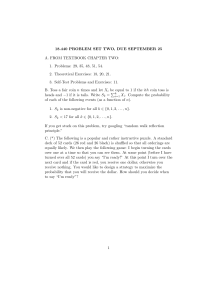

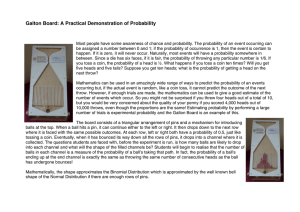
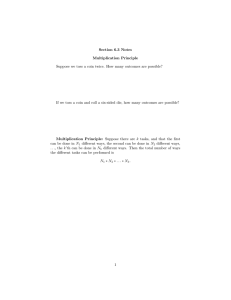
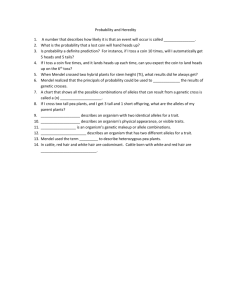
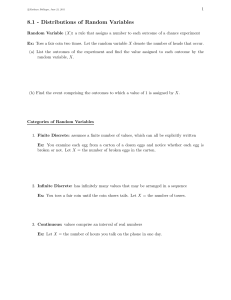
![MA1S12 (Timoney) Tutorial sheet 9c [March 26–31, 2014] Name: Solution](http://s2.studylib.net/store/data/011008036_1-950eb36831628245cb39529488a7e2c1-300x300.png)
